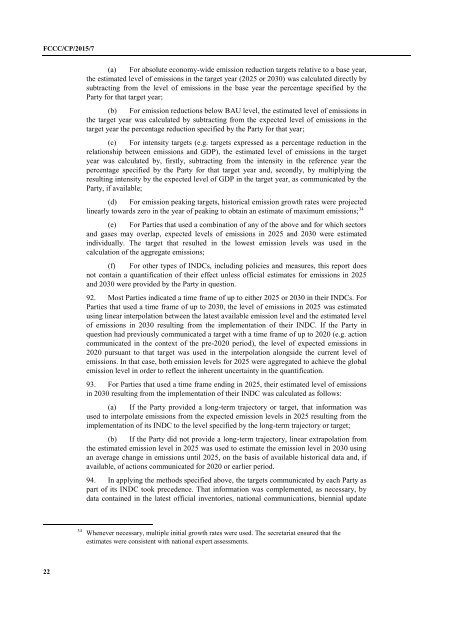FCCC/CP/2015/7
1PYuHQM
1PYuHQM
Create successful ePaper yourself
Turn your PDF publications into a flip-book with our unique Google optimized e-Paper software.
<strong>FCCC</strong>/<strong>CP</strong>/<strong>2015</strong>/7<br />
(a) For absolute economy-wide emission reduction targets relative to a base year,<br />
the estimated level of emissions in the target year (2025 or 2030) was calculated directly by<br />
subtracting from the level of emissions in the base year the percentage specified by the<br />
Party for that target year;<br />
(b) For emission reductions below BAU level, the estimated level of emissions in<br />
the target year was calculated by subtracting from the expected level of emissions in the<br />
target year the percentage reduction specified by the Party for that year;<br />
(c) For intensity targets (e.g. targets expressed as a percentage reduction in the<br />
relationship between emissions and GDP), the estimated level of emissions in the target<br />
year was calculated by, firstly, subtracting from the intensity in the reference year the<br />
percentage specified by the Party for that target year and, secondly, by multiplying the<br />
resulting intensity by the expected level of GDP in the target year, as communicated by the<br />
Party, if available;<br />
(d) For emission peaking targets, historical emission growth rates were projected<br />
linearly towards zero in the year of peaking to obtain an estimate of maximum emissions; 34<br />
(e) For Parties that used a combination of any of the above and for which sectors<br />
and gases may overlap, expected levels of emissions in 2025 and 2030 were estimated<br />
individually. The target that resulted in the lowest emission levels was used in the<br />
calculation of the aggregate emissions;<br />
(f) For other types of INDCs, including policies and measures, this report does<br />
not contain a quantification of their effect unless official estimates for emissions in 2025<br />
and 2030 were provided by the Party in question.<br />
92. Most Parties indicated a time frame of up to either 2025 or 2030 in their INDCs. For<br />
Parties that used a time frame of up to 2030, the level of emissions in 2025 was estimated<br />
using linear interpolation between the latest available emission level and the estimated level<br />
of emissions in 2030 resulting from the implementation of their INDC. If the Party in<br />
question had previously communicated a target with a time frame of up to 2020 (e.g. action<br />
communicated in the context of the pre-2020 period), the level of expected emissions in<br />
2020 pursuant to that target was used in the interpolation alongside the current level of<br />
emissions. In that case, both emission levels for 2025 were aggregated to achieve the global<br />
emission level in order to reflect the inherent uncertainty in the quantification.<br />
93. For Parties that used a time frame ending in 2025, their estimated level of emissions<br />
in 2030 resulting from the implementation of their INDC was calculated as follows:<br />
(a) If the Party provided a long-term trajectory or target, that information was<br />
used to interpolate emissions from the expected emission levels in 2025 resulting from the<br />
implementation of its INDC to the level specified by the long-term trajectory or target;<br />
(b) If the Party did not provide a long-term trajectory, linear extrapolation from<br />
the estimated emission level in 2025 was used to estimate the emission level in 2030 using<br />
an average change in emissions until 2025, on the basis of available historical data and, if<br />
available, of actions communicated for 2020 or earlier period.<br />
94. In applying the methods specified above, the targets communicated by each Party as<br />
part of its INDC took precedence. That information was complemented, as necessary, by<br />
data contained in the latest official inventories, national communications, biennial update<br />
34 Whenever necessary, multiple initial growth rates were used. The secretariat ensured that the<br />
estimates were consistent with national expert assessments.<br />
22


